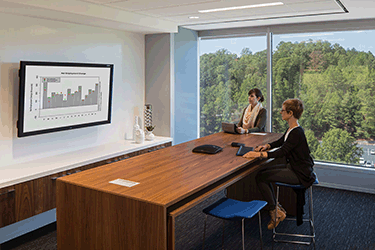Intercontinental Exchange’s challenge to TI was to create collaboration spaces that non-technical users could quickly and easily start presenting, did not use any of the credenza’s or cabinetry to house any AV technology, and were all up and running in nine months.
Intercontinental Exchange’s challenge to TI was to create collaboration spaces that non-technical users could quickly and easily start presenting, did not use any of the credenza’s or cabinetry to house any AV technology, and were all up and running in nine months.
The most difficult part was to commit to an infrastructure design while the details of the AV system functionality were still being refined by the client’s project stakeholders. To minimize the impact of end user driven design changes and the desire to keep equipment out of the individual rooms, TI chose to centralize the equipment racks in an AV closet in a consistent location on each floor. This allowed TI to make performance modifications in the AV rack and not in the rooms. Headroom on the switching systems allows the technology to be scaled up as their needs grow
.
The first two floors of conference rooms and the cable head end system had to be completed in 8 weeks which meant that TI was literally installing right behind the general contractor and the furniture installers. Then it was a floor every two weeks for the balance of the project.
- Many of the AV systems were dependent on the client’s local area network, and specialized V-LAN’s had to be established to segregate the AV traffic from the client’s production network. Hundreds of man hours were invested in order to coordinate with ICE’s IT team to make all of the network dependent AV equipment perform.
